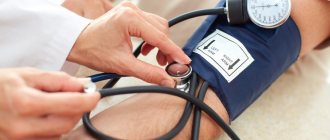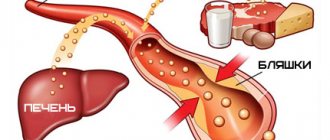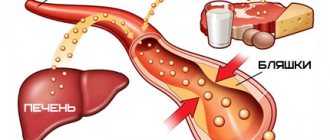What does cholesterol look like?
Many people think of cholesterol as fat and believe that the fattier the food, the more cholesterol it contains. This point of view is only partly justified. Cholesterol is found in the blood and looks like a viscous substance. Cholesterol cannot be considered exclusively harmful, because it is consumed by the body in the process of producing hormones and forming cell membranes. To varying degrees, cholesterol is involved in the functioning of the immune, nervous and digestive systems, so a certain amount of cholesterol must be contained in the body at all times. Another thing is that keeping it within acceptable limits is not always easy.
Excess cholesterol
tends to deposit on the inner walls of arteries.
At first, this is an imperceptible process, but gradually, due to the cholesterol layer, the diameter of the artery narrows, and blood begins to pass through it worse. In places where the vessel narrows, a dense formation is formed from the cholesterol layer, which is commonly called a “ cholesterol plaque
.”
Cholesterol plaques not only almost completely block the flow of blood through the vessel, but also reduce its elasticity. The process of cholesterol formation is called “ atherosclerosis
”.
By themselves, single cholesterol plaques do not pose a serious health hazard, but if you do not take action, over time there will be too many of them. In addition, cholesterol plaque
- This is the initial stage of
thrombus
. Often blood clots form where atherosclerotic plaques were located. The danger of a blood clot is that it completely seals the vessels and can block the flow of blood to vital organs. If a blood clot occurs in a vessel supplying the heart, a person may have a myocardial infarction, and if blood flow stops in a vessel supplying the brain, the person may suffer a stroke.
Does high cholesterol cause death?
Cholesterol itself is not considered deadly. Complications caused by high cholesterol levels can lead to death. We have already named some of them. Atherosclerosis can trigger the development of coronary heart disease, and one of the complications can be myocardial infarction, stroke, acute thrombosis and other diseases. The list can be large and is determined by which arteries were affected.
New cholesterol controversy
When do you really need to lower cholesterol and who can live long with high levels? The material about this, prepared by KP, was among the top most read on the newspaper’s website.
Dossier "KP"
Philip Kopylov is a professor at the Department of Preventive and Emergency Cardiology, Director of the Institute of Personalized Medicine at Sechenov University, Doctor of Medical Sciences, researcher, cardiologist.
THE MAIN CHALLENGE FOR DOCTORS
Recently, an international group of cardiologists from Sweden, Italy, France, Japan and other countries made a revolutionary statement: there is no evidence to conclusively support the connection between high levels of “bad” cholesterol and cardiovascular disease. The researchers came to this conclusion after studying data from 1.3 million patients. Their health status was monitored for a total of about 50 years. Even more surprising, according to cardiologists, was that older people with high levels of low-density lipoproteins (the same “bad” cholesterol) live on average longer than others! How is this possible? Does this mean that scrambled eggs, butter and fatty meats have been finally rehabilitated, and doctors need to reconsider their approaches to treating heart patients with statin drugs?
“There may be two people standing in front of us, both of them have high cholesterol, only one needs to be treated, and the second can be left alone,” says Philip Kopylov. - Essentially, this is a solution-explanation of the results of a study on the role of cholesterol, which surprised many. The secret is that monitoring people from different risk groups gives different results. And medications act in different ways: if you give them to a sick person according to medical indications, his condition will improve. But if you feed someone who is healthy or who is not so sick that they really need serious medications, then there will be no improvement. The main task, I would even say a challenge, for modern doctors is to determine those who really need to lower cholesterol and when such patients really need statins. Because other people can live longer without treatment, including those with relatively high levels of “bad” cholesterol.
CHECK YOURSELF
What is your risk of cardiovascular disease?
A person is at low risk if they:
a) no high blood pressure. That is, the pressure is not higher than 130/80 mm Hg. Art. under the age of 65 and not higher than 140/80 after 65 years;
b) no excess weight. That is, the body mass index is not higher than 29 (we talked about how to calculate it in the first part of the publication);
c) no diabetes;
d) no atherosclerosis.
- Under such conditions, the patient usually does not need to be treated even if the level of “bad” cholesterol is elevated. That is, if the level of LDL (low-density lipoprotein) in the blood is up to 4.9 mmol/l, explains Philip Kopylov.
If a person is at high risk of cardiovascular disease, including a high risk of heart attack and stroke, then the cholesterol level should be no more than 2.6 mmol/l. And at a very high risk - a maximum of 1.8 mmol/l . If the indicators are higher, they need to be reduced, including with the help of medications.
into the high and very high risk group (depending on the number of risk factors and the degree of neglect) if:
1) is obese. The most dangerous thing is abdominal, that is, in the abdomen. Measure your waist width: for men the critical mark is 102 cm and more, for women – 88 cm and more;
2) high blood pressure (see point “a” above);
3) there is a diagnosis of diabetes mellitus (as a general rule, it is made when the blood sugar level is above 6.7 mmol/l on an empty stomach);
4) the patient abuses salt - exceeds the norm of 5 mg per day, including salt in all dishes and products;
5) overindulges in alcohol. Let us remind you that, according to the latest data, up to 14 servings of alcohol per week for men and up to 8 servings for women are considered relatively safe for health (how much this will be in different types of drinks - see the “Health” section on kp.ru);
6) male gender - the risk of cardiovascular diseases in men is a priori higher;
7) age - for women over 50 - 55 years old; for men - from 45 years old, and if the above factors are present - then starting from 35 years old.
CHOLESTEROL PLAQUE DIFFERENCES PLAQUE
- If I am not in a high or even medium risk group, does this mean that I can unlimitedly eat foods with animal fats - butter, fatty meat, etc.?
— The question is not easy. When we begin to lean on foods rich in animal fats, with a modern sedentary lifestyle, this often results in obesity. You receive at least one risk factor and move from a more “favorable” group to a less favorable one, with a higher risk. And in general, we must admit: the regulation of the system of production and metabolism of cholesterol in the body still partially remains a mystery to scientists. We don't know everything about her.
— Is it undeniable that cholesterol plaques in blood vessels are harmful and dangerous? Or do you also have doubts?
— In humans, already from adolescence, damage to the internal lining of blood vessels begins. And atherosclerotic plaques develop with age in the vast majority of people (essentially, such plaques are accumulations of cholesterol deposits in places of vascular damage. - Author) . However, the problem is that plaques are not all the same. They can be of two types: stable and unstable. And the most serious challenge in cardiology now is to learn to identify and calculate unstable plaques.
- What is their danger?
- At least half of myocardial infarctions occur due to plaques that do not narrow the lumen in the blood vessels or narrow it less than 50%. Such plaques have a thin covering film and a liquid core, where inflammation constantly occurs. Eventually the tire simply breaks. A blood clot forms at this site and blocks the lumen of the vessel. And everything downstream of the blood begins to die.
TO EXERCISE OR NOT TO EXERCISE?
- It is often said that aerobic exercise - brisk walking, running, swimming, ice skating - is useful for increasing blood circulation. And if the plaques are unstable, then it turns out that increased blood flow can worsen the situation?
— Purely theoretically, yes. However, if these loads are regular and reasonable (see below for the “golden” formula for calculating heart rate. - Author) , then they will have a positive effect. Weight and blood pressure will decrease. Also, as a rule, there is a decrease in cholesterol. That is, risk factors are eliminated, and due to this, competent physical exercise brings undeniable benefits. And if you exercise from time to time, and even try to set an Olympic record in the rare moments of your appearance at the gym, then the threat of rupture of plaques and a heart attack really increases significantly.
ON A NOTE
How to determine safe exercise intensity
Use the “golden formula” for calculating your optimal heart rate: 220 minus your age. the resulting figure by 65% - this is the pulse at a moderate load; multiply by 80% - heart rate during intense physical activity. If it is higher, there is already an excessive load, unfavorable for the blood vessels and heart.
QUESTION: WHO NEEDS STATINS?
— Philip Yuryevich, what about statins? Recently, there has been heated debate; the authors of an international study claim that the benefits of such drugs are very doubtful. To whom and why should they be prescribed from your point of view - as a researcher and cardiologist?
- Let's remember: cholesterol enters our body not only with food, 60 - 70% of it is produced in the liver, even if you are on a lean diet. The effect of statins is, on the one hand, to inhibit the production of cholesterol in the liver. At the same time, a mechanism is launched that turns existing unstable plaques into stable ones. And this actually cuts the risk of heart attacks in half.
— It turns out that if a person’s plaques are stable and do not block the lumen of blood vessels, then there are no indications for taking statins? After all, these drugs have serious side effects - from muscle and joint pain to increased blood sugar. When the task is to protect against a real threat, a fatal heart attack, then such “costs” are the lesser of the evils. Are there any current developments to determine the type of plaque in a particular patient?
— There is an intravascular method, when we insert a special sensor into the vessel and use ultrasound or optical coherence tomography to determine the structure of the plaque.
- Do you need to check every plaque?
- Yes. And the sensor, unfortunately, is expensive. Another approach is computed tomography. We put the patient in a computer scanner and do an X-ray examination with contrast of the heart vessels. The resolution of computed tomographs today makes it possible to determine what kind of plaque it is - stable or unstable.
The third approach is a blood test. Now it is actively developing. Very interesting research work is being carried out on microRNAs, that is, small molecules that are responsible for inflammation and the development of atherosclerosis. Based on their presence, concentration and combination, they are trying to build diagnostic systems to identify unstable plaques.
— Are any of these methods used in Russia?
- So far - on a minimal scale, only in large cardio centers, and then as research work for the most part. In general, the problem of determining the type of plaques is solved in different ways throughout the world. The latest international recommendations propose the introduction of computed tomography with contrast as a method of primary diagnosis.
CONGRATULATIONS!
“Sechenovka” has an anniversary!
In 2021, Sechenov University, First Honey, the legendary “Sechenovka”, as it is often called among the people, turns 260 years old. Over these centuries, they worked, taught, treated, created breakthrough methods for saving people here, and most Russian medical luminaries continue to do so. Among the stars of the university is the founder of the school of military field medicine, Nikolai Pirogov ; famous surgeon, professor Nikolai Sklifosofsky ; the founder of Russian forensic psychiatry Vladimir Serbsky ; founder of the medical examination system Nikolai Semashko ; founder of neurosurgery Nikolai Burdenko; founder of the school of cardiovascular surgery Alexander Bakulev . Now among the professors at Sechenovka are academician Leo Bockeria , the chief transplantologist of the Russian Ministry of Health, academician Sergei Gauthier , one of the leading Russian oncological surgeons, an expert on head and neck tumors, academician Igor Reshetov , and many others.
«
Komsomolskaya Pravda" congratulates Sechenov University and wishes new scientific and medical breakthroughs!
Link to publication:
Is all cholesterol the same?
Cholesterol is found in the blood, but does not dissolve in it. Cholesterol is carried throughout the body by lipoproteins. High density lipoprotein (HDL) molecules
move cholesterol from the arteries to the liver. Later, this cholesterol is excreted from the body and is not deposited on the walls of blood vessels. Such cholesterol is considered “good” because it not only does not increase, but reduces the risk of developing cardiovascular diseases.
Another type of cholesterol carried by low-density lipoprotein (LDL) molecules
from the liver throughout the body. In peripheral tissues, cholesterol gradually settles on the walls of blood vessels, resulting in the formation of atherosclerotic plaques. It is important for a person to monitor and prevent an increase in the level of low-density lipoproteins, or “bad” cholesterol.
Another form of lipids that provide the body with energy, but in large quantities can be harmful, are triglycerides. They are synthesized by the liver or enter the body with food, and then pass into the blood. A high content of triglycerides in the blood is also undesirable, since it can disrupt the functioning of the circulatory system.
Upper and lower limits of normal for women. Table with main indicators
The data indicated in the table is for informational purposes only. To carry out tests, contact your local physician or a certified laboratory. IMPORTANT: only a doctor can correctly interpret the results, taking into account the patient’s medical history, her complaints (or lack thereof) and other diagnostic data.
| Age | Total cholesterol (TC), mmol/l | High-density lipoprotein cholesterol (good, HDL), mmol/l | Low-density lipoprotein cholesterol (bad, LDL), mmol/l | Triglycerides (TG), mmol/l |
| 15–20 years | 3,08–5,18 | 0,91–1,91 | 1,53–3,55 | 0,44–1,4 |
| 20–25 years | 3,16–5,59 | 0,85–2,04 | 1,48–4,12 | 0,41–1,48 |
| 25–30 years | 3,32–5,75 | 0,96–2,15 | 1,84–4,25 | 0,42–1,63 |
| 30–35 years | 3,37–5,96 | 0,93–1,99 | 1,81–4,04 | 0,44–1,70 |
| 35–40 years | 3,63–6,27 | 0,88–2,12 | 1,94–4,45 | 0,45–1,99 |
| 40–45 years | 3,81–6,53 | 0,88–2,28 | 1,92–4,51 | 0,51–2,16 |
| 45–50 years | 3,94–6,86 | 0,88–2,25 | 2,05–4,82 | 0,52–2,42 |
| 50–55 years | 4,20–7,38 | 0,96–2,38 | 2,28–5,21 | 0,59–2,63 |
| 55–60 years | 4,45–7,77 | 0,96–2,35 | 2,31–5,44 | 0,62–2,96 |
| 60–65 years | 4,45–7,69 | 0,98–2,38 | 2,59–5,80 | 0,63–2,70 |
| 65–70 years | 4,43–7,85 | 0,91–2,48 | 2,38–5,72 | 0,68–2,71 |
| > 70 years | 4,48–7,25 | 0,85–2,38 | 2,49–5,34 | 0,68–2,71 |
What increases cholesterol?
Increased cholesterol levels can be due to various factors. The first thing you should pay attention to is your diet
.
If a person has a slight increase in cholesterol levels, doctors usually recommend that they eat less foods high in saturated fat, but certain health problems can also contribute to high cholesterol levels. For example, chronic renal failure or decreased thyroid function. Some people may have high cholesterol levels “naturally” and be inherited. This genetic abnormality is called “ familial hypercholesterolemia
”.
When shaping your diet, you need to remember that cholesterol is found only in products of animal origin. This argument is often made in favor of a plant-based diet by vegetarians. However, this does not mean that if animal food is excluded, the rest of the diet can be uncontrolled. Food fried in vegetable oil and products containing palm oil can also have a negative effect on lipid metabolism.
Treatment methods
To normalize the level of fatty alcohol, you should take medications belonging to the group of statins. This category of drugs is ineffective in treating people over 70 years of age. The use of statins does not help reduce the risk of developing pathologies of the cardiovascular system. Self-treatment with statins is unacceptable!
During therapy aimed at reducing cholesterol in the blood, you should:
- maintain a physical activity regime;
- fight excess body weight;
- establish a balanced diet;
- give up alcoholic beverages and smoking.
Diets that help lower cholesterol
First of all, it is important to review your own menu. Animal fats present in the diet should be reduced, but they should not be completely excluded from the diet. The daily menu should contain in small quantities:
- cheese;
- milk;
- low-fat kefir;
- eggs, etc.
Food containing trans fats is completely removed from the menu. Fast foods should be a thing of the past if the goal is to reduce the percentage of organic compounds. In the case when cholesterol adjustment occurs in the last months of pregnancy, you should slightly limit unhealthy foods and make dietary changes.
During treatment, a diet must be maintained if the patient suffers from:
- overweight;
- metabolic disorders;
- liver pathology;
- kidney pathology.
It is also important to control high/low cholesterol during pregnancy
If the level of organic compounds in the blood increases, the diet should be supplemented with the right fats, which are found in large quantities in sea fish, olive oil, nuts, and legumes. This category of products has a positive effect on lipid metabolism. The following should be completely excluded from the daily menu:
- mayonnaise and fatty sauces;
- cakes, buns, pastries;
- smoked products;
- fast foods;
- Palm oil;
- margarine.
Vitamin B and folic acid should be added to the diet. A deficiency of useful elements often leads to the formation of atherosclerotic plaques. A table saturated with valuable microelements stabilizes total cholesterol.
The basis of nutrition should be:
- cabbage;
- beet;
- mushrooms;
- fresh fruits;
- fresh vegetables;
- greenery;
- buckwheat and rice;
- lean meat;
- kefir.
Dish recipes
Food should either be baked, boiled, stewed or steamed. It is best to give preference to simple recipes for healthy dishes. Several times a week you should bake sea fish in the oven with onion and tomato rings. For fish dishes, you can serve a light salad prepared with cucumbers, avocado, herbs and vegetable oil.
You should enjoy stewed rabbit twice a week. Tender dietary meat is cut into pieces and stewed over low heat together with onions. You can use buckwheat porridge as a side dish.
Do healthy people need to monitor their cholesterol?
Often people begin to monitor certain indicators when problems appear and their health worsens, but prevention is always better than cure. The concept of “healthy person” is too general. You may not have liver or metabolic problems now, but that doesn't mean you won't have them in the future. People with identified lipid metabolism disorders should regularly undergo cholesterol tests, but others should not check the strength of their body.
If your diet often contains fatty foods, high-calorie foods, and in general you like to indulge in sweets, then sooner or later this will increase your cholesterol. Other cardiovascular risk factors may also have an impact. As a result, you risk getting atherosclerosis with all the attendant consequences.
Cholesterol norm
If, according to the test results, your cholesterol is normal, then there is no serious cause for concern. Provided you follow the rules of a healthy diet and a healthy lifestyle, the next examination can be done in a few years.
If the cholesterol level is elevated ( from 5 to 6.4 mmol/l or more
), then it’s worth monitoring it every six months to observe the dynamics. At the same time, you need to reconsider your diet, remove foods that increase cholesterol, and also give up bad habits: smoking and drinking alcohol. Your doctor should warn you about additional risks associated with the presence of concomitant diseases.
over 6.4 mmol/l is considered a high-risk level.
. This indicator indicates the need for specialized treatment, since there is a high probability of developing coronary heart disease and other cardiovascular complications. The treatment program should be drawn up by a doctor based on the tests performed, including identifying the level of LDL, HDL and triglycerides.
Risk group for atherosclerosis
Atherosclerosis
- an insidious disease that develops gradually. Cholesterol level is an indirect indicator of the risk of developing atherosclerosis, but some categories of people need to be tested for cholesterol at certain intervals. The following recommendations are given:
- men over 40 years old;
- women over 45 years old;
- people with diagnosed diabetes;
- overweight people;
- people with diseases of the thyroid gland, kidneys and high blood pressure;
- smokers;
- people who lead a sedentary lifestyle.
It is important to understand that at the first stage of development, atherosclerosis has no visible specific manifestations. A person may not even be aware of the developing disease and the problem with cholesterol. Therefore, doctors recommend regularly donating blood for biochemical analysis.
Why is high cholesterol dangerous?
Elevated cholesterol levels lead to the risk of developing coronary artery disease and myocardial infarction, ischemic stroke and gangrene of the extremities!
It is necessary to reduce the concentration of total cholesterol in the blood: a decrease in the concentration of total cholesterol in the blood by 10% leads to a reduction in mortality from heart disease by 20%. Little physical activity (physical inactivity), excess nutrition and smoking have a bad effect on cholesterol levels.
Physical exercise and weight loss reduce the concentration of cholesterol and triglycerides, thereby preventing the development of atherosclerosis.
When should you start monitoring your cholesterol?
It's never too early for prevention. It’s better to get used to monitoring your health from a young age, then it will present you with fewer unpleasant surprises. It is especially important to pay attention to your health after 40 years of age
, this is true for both men and women. In men, coronary heart disease may begin to develop earlier than in women. This is explained by hormonal levels. Women of childbearing age have more “good” cholesterol in their bodies, while in men the preponderance may lean toward “bad” cholesterol. After menopause, women's bad cholesterol levels may also begin to rise along with their triglyceride levels.
If previously it was believed that atherosclerosis mainly affects mature and elderly people, now the disease is diagnosed in younger patients, so it would be reasonable to start controlling cholesterol levels at 30-35 years of age. If the analysis shows that everything is normal, a re-check can be carried out after 3-4 years, but if the cholesterol level is elevated or there is a genetic predisposition to the development of heart and vascular diseases, then it is worth checking the cholesterol level more often.
Do children suffer from high cholesterol?
Cholesterol levels in children, as a rule, do not rise above normal, but they can also be at risk if hereditary hypercholesterolemia is found in their family. In this case, the child will be registered with a pediatric cardiologist from an early age. A cholesterol test should be done at the age of two years, and then repeated periodically.
Classification of the disease
The formation of atherosclerotic plaques can occur in individual vessels or affect most of them. Depending on the organ in which blood flow is reduced and the affected artery, the following forms of the disease are distinguished:
- Heart shape. Ischemic atherosclerosis with damage to coronary vessels and valves.
- Kidney form. The renal arteries are affected.
- Brain (cerebral) form. The disease spreads to intracranial vessels.
- Intestinal form. The mesenteric arteries are affected.
- Atherosclerosis of the aorta. Its abdominal region is most often affected.
- Atherosclerosis of the arteries of the lower extremities, mainly femoral.
- Atherosclerosis of brachiocephalic vessels. These include the right carotid, vertebral and subclavian arteries.
Symptoms of high cholesterol
It is possible to determine the exact level of cholesterol in the body only after an analysis, but there are symptoms that may indicate the presence of disturbances in the functioning of the body. This will not allow you to make a diagnosis, but it should be a reason to visit a lipidologist or cardiologist. Make an appointment for a preventive appointment if:
- physical activity or excessive anxiety provokes the appearance of aching pain in the chest;
- even minor physical activity causes a feeling of lack of oxygen;
- you begin to get tired faster, and fatigue is accompanied by a feeling of heaviness in the chest area;
- you often have a headache for no reason, there is noise in your ears, you feel oxygen starvation to the point of fainting.
If you notice the symptoms described, make an appointment with your doctor. It will be enough to visit a therapist so that he can conduct a preventive examination and, if necessary, refer you to other specialized specialists.
The diagnosis of atherosclerosis is difficult to make without biochemical and instrumental examination, so be prepared for the fact that you will have to undergo a series of tests. The examination usually begins with a blood test and an ECG.
. Then, depending on the results obtained, a treatment program is prescribed, if necessary. The patient’s blood is usually taken from a vein, but if a quick result is needed, it can be obtained using the express method by drawing blood from a finger. To obtain more accurate results, it is recommended to donate blood on an empty stomach.
Diagnostics and tests
To establish why cholesterol has increased, a comprehensive examination of the body is necessary. To determine the level of lipophilic alcohol, after collecting anamnesis, auscultation and measuring blood pressure, the following laboratory diagnostic methods are prescribed:
- blood chemistry;
- lipid profile study;
- immunological analysis.
If you want to identify a genetic defect that may be causing high cholesterol, you may need to donate blood to test the patient's relatives.









